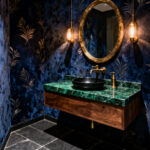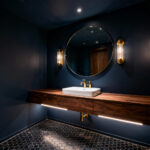Imagine coming home after a long, stressful day and stepping into a sanctuary designed to soothe your senses and calm your mind instantly. In minimalist design, the power of color cannot be understated. With the right palette, your bedroom transforms from a mere sleeping quarters into a refreshing oasis, where every hue whispers tranquility and invites you to surrender to the embrace of serenity.

In this article, we’ll explore the transformative world of color and curate the perfect palette for your minimalist bedroom. From the calming effects of neutrals to the strategic use of accent colors, we’ll unravel the secrets to creating a harmonious and rejuvenating space that nurtures your well-being and promotes restful slumber.
Understanding Neutral Colors: The Foundation of a Minimalist Bedroom
As a minimalist design enthusiast, I can’t emphasize enough the transformative power of neutral colors in creating a serene and spacious bedroom sanctuary. They provide the perfect backdrop for other design elements, allowing your space to breathe and your mind to find tranquility.

The Calming Effect of White
White is a true chameleon, capable of evoking a range of moods depending on its shade. A crisp, cool white can instill a sense of freshness and clarity, while a warmer, creamier white exudes coziness and comfort. Regardless of the hue, white reflects light beautifully, making even the smallest spaces feel open and airy.
Warmth and Comfort with Beige
Beige is your ally if you’re seeking a bedroom that envelops you in warmth and relaxation. With its earthy undertones, this versatile neutral creates an inviting and comforting atmosphere. Beige can add depth and dimension to your minimalist haven, from soft tans to rich caramels.
Sophistication with Gray and Black
Gray and black are excellent choices for those seeking a touch of drama and sophistication. These moody hues can lend a sense of depth and elegance to your minimalist bedroom. They can create a cozy and intimate ambiance when used judiciously, perfect for unwinding after a long day.

Remember that while neutral colors form the foundation, a pop of color can add personality and visual interest to your minimalist bedroom.
Adding Personality with Accent Colors: Pops of Color for Visual Interest
Wouldn’t it be dull if your minimalist bedroom was just a sea of neutral tones? That’s where accent colors come into play, adding personality and visual interest to your sanctuary. These pops of color can be used sparingly to create focal points or add vibrancy without overwhelming the overall minimalist vibe.

Tranquility with Blue Accents
Blue is associated with calmness and serenity, making it the perfect accent color for creating a relaxing atmosphere in your bedroom. Use blue accents like throw pillows, artwork, or a cozy blanket to promote peace and tranquility. For a spa-like ambiance, consider incorporating shades of blue-green or turquoise.
Nature’s Touch with Green Accents
Bring the outdoors in with green accents! Green promotes feelings of peace and harmony, making it an excellent choice for a minimalist bedroom. Incorporate green through potted plants, a nature-inspired wall hanging, or even a subtle green throw blanket. Be careful not to overdo it; too much green can feel overwhelming in a small space.

Sunshine and Joy with Yellow Accents
Are you looking to brighten up your minimalist bedroom? Yellow accents are the way to go! This cheerful hue evokes feelings of happiness and optimism, making it perfect for adding a touch of energy to your space. Use yellow sparingly, perhaps with vibrant artwork or a few throw pillows, to create a sunny and joyful ambiance.
Romantic Vibes with Pink Accents
Consider incorporating pink accents into your minimalist bedroom for a soft and romantic ambiance. Pink is associated with love and compassion, making it the perfect choice for creating a cozy and inviting space. Use shades of blush or dusty rose in accent pieces like curtains, a plush rug, or a comfy throw blanket.
Choosing the right accent colors can transform your minimalist bedroom from a bland, neutral space into a calming, personalized retreat. Just remember to use them sparingly and consider the psychological effects of each hue to create the perfect ambiance for your sanctuary.

How can blue be used to create a spa-like atmosphere in a bedroom? Incorporate shades of blue-green or turquoise into your decor, such as through bedding, artwork, or even a calming blue-toned paint color on the walls.
What are the best ways to incorporate green into a minimalist bedroom without overwhelming the space? Stick to a few green accents, like potted plants or a nature-inspired wall hanging, and balance them with plenty of neutral tones to keep the space airy and minimalist.
How can yellow brighten up a dark bedroom? Add a pop of sunshine with vibrant yellow artwork or a few cheerful yellow throw pillows. Be sure to use yellow sparingly, as too much can feel overpowering in a small space.
What are some creative ways to use pink accents in a minimalist bedroom? For a romantic and cozy touch, consider a soft pink area rug, blush-toned curtains, or even a dusty rose throw blanket.

Remember, moderation is key to using accent colors in a minimalist bedroom. Choose colors that complement your neutral palette and use them sparingly to create focal points and add visual interest without overwhelming the space.
Striking the right balance between neutrals and accents is crucial in creating a harmonious, calming, minimalist bedroom. How can you find that perfect equilibrium?
Creating Harmonious Color Combinations: Finding the Perfect Balance
Have you ever walked into a room and felt an instant calm wash over you? That’s the power of carefully curated color combinations! As a home decor and gardening expert, I can’t stress enough the importance of understanding color theory when creating a serene, harmonious, minimalist bedroom.

Complementary Colors: Creating Contrast
Let’s start with complementary colors – those bold and vibrant hues that sit opposite each other on the color wheel. Think blue and orange, red and green, or purple and yellow. When used thoughtfully, complementary colors can add a touch of drama and energy to your minimalist sanctuary. For instance, you could pair a soft gray wall with pops of mustard yellow in your bedding or accent pieces. The contrast is striking yet calming.
Analogous Colors: Achieving Harmony
Consider an analogous color scheme if you’re looking for a more soothing vibe. These colors are neighbors on the color wheel, like shades of blue and green or warm reds and oranges. They create a sense of harmony and cohesion, perfect for a minimalist bedroom where you want to unwind after a long day. Imagine a space with soft sage walls, a muted teal duvet, and pops of olive green in your decor – pure tranquility!

Monochromatic Colors: Simplicity and Elegance
For those who truly embrace the minimalist lifestyle, a monochromatic color scheme might be the way to go. This sophisticated approach uses different shades and tints of a single hue, creating a sleek and refined look. Picture a bedroom awash in shades of gray, from the lightest silver to the deepest charcoal. Add texture with different fabrics and materials, and you’ve got a simple and visually interesting space.
Remember, the 60-30-10 rule is your friend when it comes to color combinations. Use the dominant hue for about 60% of the room, a secondary color for 30%, and an accent color for the remaining 10%. This ratio ensures a balanced and harmonious space that feels calm and inviting.

How can complementary colors be used effectively in a minimalist bedroom? Use them sparingly as accents to add a pop of energy and contrast against a neutral backdrop. What are some examples of successful analogous color schemes for bedrooms? Think cool blues and greens or warm peaches and corals. How can a monochromatic color scheme create a visually interesting space? Play with different textures and materials in the same hue to add depth and dimension.
The key is to choose a color scheme that aligns with your desired mood and style. Don’t be afraid to experiment and have fun with different combinations until you find the perfect palette that helps you truly unwind and recharge.
So, are you ready to color your way to calm? Let’s move on to the next section, where we’ll explore the psychological effects of color and how they can impact your mood and sleep quality.

The Psychological Effects of Color: Understanding the Impact on Mood and Sleep
Did you know that the colors you choose for your bedroom can significantly impact your mood and sleep quality? It’s true! Colors are not just aesthetic choices; they can influence our emotions and well-being.
Warm Colors: Energy and Passion
Warm colors like red and orange are known for their energizing and stimulating properties. Red, in particular, is associated with passion, excitement, and even increased heart rate. While these colors can add a vibrant touch to your living spaces, they may not be the best choice for a bedroom where relaxation is the priority.

Cool Colors: Calmness and Relaxation
Conversely, cool colors like blue and green are known for their calming and soothing effects. Blue is often associated with tranquility and serenity, making it an excellent choice for creating a peaceful and relaxing atmosphere in your bedroom. With its connection to nature, green can also promote a sense of harmony and balance.
The Impact of Light and Dark Colors
In addition to the color itself, the lightness or darkness of a shade can also influence the mood of a space. Light colors make a room feel more open and airy, while darker hues create a cozy and intimate ambiance. For example, a light blue or soft green can make a small bedroom feel more spacious, while a deep navy or forest green can add warmth and coziness.
How does the color red affect sleep quality? While red can be an energizing and passionate color, it may not be the best choice for a bedroom where restful sleep is the goal. Cool colors like blue and green are generally better options for promoting relaxation and a good night’s sleep.

What are the best colors for promoting relaxation in a bedroom? Cool colors like blue and green and soft neutrals like gray or beige are often recommended for creating a calming and serene atmosphere.
How can light and dark colors create different moods in a bedroom? Light colors make a room feel more open and airy, while darker shades create a cozy and intimate ambiance. Consider using lighter colors for a spacious feel or darker hues for a comfortable, enveloping atmosphere.
Remember, when choosing colors for your minimalist bedroom, consider their aesthetic appeal and the psychological effects they can have on your mood and sleep quality. You can create a truly calming and rejuvenating space with the right color palette.

While color is crucial in creating a relaxing atmosphere, other factors exist, such as lighting, textures, and minimalist design principles. How can you incorporate these elements to create a serene and harmonious bedroom environment?
Conclusion
Color is the foundation in pursuing a truly serene and harmonious minimalist bedroom. To elevate your sanctuary to new heights of tranquility, consider the interplay of lighting, textures, and minimalist design principles. Soft, diffused lighting can create a cozy ambiance, while carefully curated textures add depth and interest without sacrificing simplicity.
Embrace the principles of minimalism by decluttering your space and curating a few thoughtfully chosen pieces that serve a purpose and delight the senses. Remember, the essence of minimalist design lies in its ability to strip away the unnecessary and reveal the beauty in simplicity.

As you embark on this transformative journey, allow yourself to be guided by your intuition and personal preferences. After all, your minimalist bedroom should reflect your inner sanctuary – a space that nurtures your soul and beckons you to embrace the art of mindful living.






